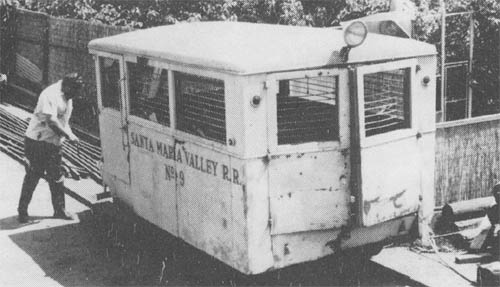R-45-3
Shortly after this big downfall, the way to bigger things came with the added attraction to donors �- Federal tax exemption. After many letters were penned by Terry Durkin, a locomotive was donated in May, 1966. The good news came! The E. J. Lavino & Company of Sheridan, Pennsylvania had donated a locomotive to the museum. This locomotive was a coal-burning 0-6-0T. It was built by Alco in 1923, and was the Lavino Company's Number 10.
Things began to happen quite rapidly that May in 1966. On May 13, the Mojave Northern Railway locomotive Number 3, also an 0-6-0T, was donated to the museum by The Pacific Southwest Portland Cement Co. The MN locomotive was located at Victorville, California.
Although the Lavino engine was the first to be owned by the museum, the engine from Victorville was the first to arrive, The Mojave Northern locomotive was not the first to be operated by the museum. It probably would have been, but, alas, it was found to have a damaged crown sheet.
Another engine, the former Number 10 of the Pickering Lumber Company, was donated to PSRMA. Even though the locomotive was a rare Heisler type, it was soon transferred to the Pacific Locomotive Association, where it would provide parts for similiar locomotives. The locomotive has since gone to the Klamath and Hoppow Valley Railroad at Klamath, California, where it will be used as backup power for their 2-8-2T. The museum's decision to transfer this locomotive was not easy. But it was considered necessary in view of the financial strain already placed on the museum by the arrival of so many locomotives at one time.
Georgia Pacific Corporation, early in 1967, donated yet another locomotive to the museum. The engine, now in San Diego, is a 90-ton Shay. The Shay came from Georgia Pacific's feather River Ry. It was built in 1923, by Lima, weighs 204,704 pounds, is oil burning, and carries builders number 3221. The Shay is in good running condition and last received an ICC inspection in 1966. No. 3 last saw service in 1965. Our museum has operated the engine several times on a spur in San Diego.
Expected to arrive in San Diego sometime early this year is a "Minerates" type 2-8-2T. This one was donated to the museum, by the Coos Bay Timber Division of Georgia Pacific. This one, an oil-burner, comes from Powers, Oregon.
Financing the transportation costs for these locomotives has been a great problem for the PSRMA. To date, close to $3000.00 has been raised for the purpose of paying these costs. Even at that, about $1500 is needed to complete the job.
Now that the Pacific Southwest Railway Museum has obtained operating equipment, it is well on the way. One of the major remaining obstacles to be surmounted by the museum is to acquire the necessary land to build and operate an operating exhibit. The goal is to obtain land soon near the San Diego area. Due to the nature of the equipment owned by the group, a location on a rail line is preferred. Let's face it, rail access is almost a necessity.
So, as it has been since 1959, when 12 railfans met to discuss the formation of a rail museum, land is still the key to the development of the Pacific Southwest Railway Museum Association.
MEETING NOTICE
It's 1968! Let's make it a big year for PSRMA. Remember ITS TIME FOR DUES. Please come to business meetings. Here are the dates scheduled for this year: January 21, April 21, July 21 and October 20. Other meetings will be on the third Sunday of the month as and when announced.
Board of directors will meet on the second Tuesday evening. Location of board meetings is the Board of Director's Room, San Diego Trust and Savings Bank, Main Branch. Museum members may attend board meetings, but are not entitled to vote.

Santa Maria Valley No. 9 looks a lot different now that she has been reconditioned. Built by Fairmont, she is a rare one indeed. -Eric Sanders photo.
| BACK | HOME | EXCURSIONS | GALLERY | FAQ | HISTORY | STORIES | SOUNDS | LINKS |